
The harp is a stringed musical instrument that has individual strings running at an angle to its soundboard; the strings are plucked with the fingers. Harps can be made and played in various ways, standing or sitting, and in orchestras or concerts. Its most common form is triangular in shape and made of wood. Some have multiple rows of strings and pedal attachments.

A psaltery is a fretboard-less box zither and is considered the archetype of the zither and dulcimer. Plucked keyboard instruments such as the harpsichord were also inspired by it. Its resonance box is usually trapezoidal, rectangular or in the form of a "pig's head" and often richly decorated.
The alto clarinet is a woodwind instrument of the clarinet family. It is a transposing instrument pitched in the key of E♭, though instruments in F have been made. In size it lies between the soprano clarinet and the bass clarinet. It bears a greater resemblance to the bass clarinet in that it typically has a straight body, but a curved neck and bell made of metal. All-metal alto clarinets also exist. In appearance it strongly resembles the basset horn, but usually differs in three respects: it is pitched a whole step lower, it lacks an extended lower range, and it has a wider bore than many basset horns.

The Autophone was an early type of organette, invented in 1878 by Henry Bishop Horton. One of the first table-top organettes to be mass-produced, it played music using punched cards to activate 22 reeds.
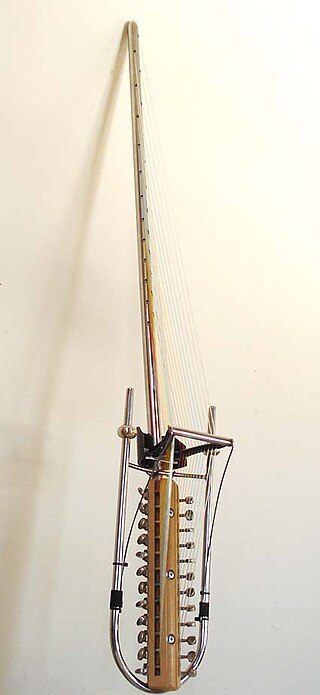
The Gravikord is a 24 string electric double bridge-harp invented by Robert Grawi in 1984, which is closely related to both the West African kora and the mbira. It was designed to employ a separated double tonal array structure making it possible to easily play cross-rhythms in a polyrhythmic musical style in a modern electro-acoustic instrument. The Gravi-kora is a similar instrument, also developed by Grawi, which is tuned identically to a traditional 21 string kora.

The violin family of musical instruments was developed in Italy in the 16th century. At the time the name of this family of instruments was viole da braccio which was used to distinguish them from the viol family. The standard modern violin family consists of the violin, viola, cello, and (possibly) double bass.
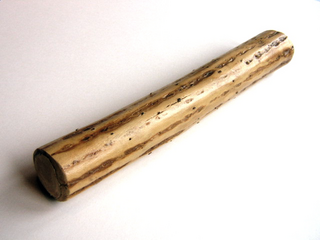
The word shaker describes various percussive musical instruments used for creating rhythm in music.

The Celtic harp is a triangular frame harp traditional to the Celtic nations of northwest Europe. It is known as cláirseach in Irish, clàrsach in Scottish Gaelic, telenn in Breton and telyn in Welsh. In Ireland and Scotland, it was a wire-strung instrument requiring great skill and long practice to play, and was associated with the Gaelic ruling class. It appears on Irish coins, Guinness products, and the coat of arms of the Republic of Ireland, Montserrat, Canada and the United Kingdom.

The cross-strung harp or chromatic double harp is a multi-course harp that has two rows of strings which intersect without touching. While accidentals are played on the pedal harp via the pedals and on the lever harp with levers, the cross-strung harp features two rows so that each of the twelve semitones of the chromatic scale has its own string.
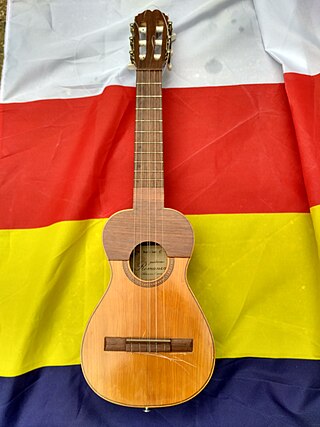
The Guitarro is a small, baroque, five-stringed guitar from Aragon, slightly larger than the requinto or cavaquinho. The instrument is also found in other regions of Spain, such as Andalusia, La Mancha, and Murcia.

The origins of the triangular frame harp are unclear. Triangular objects on the laps of seated figures appear in artwork of Ireland, Scotland, England and Wales, as well as other parts of north-west Europe. This page outlines some of the scholarly controversies and disagreements on this subject.
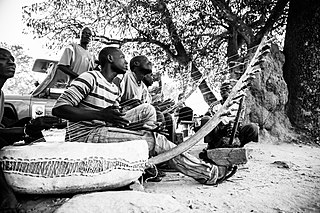
African Harps, particularly arched or "bow" harps, are found in several Sub-Saharan African music traditions, particularly in the north-east. Used from early times in Africa, they resemble the form of harps in ancient Egypt with a vaulted body of wood, parchment faced, and a neck, perpendicular to the resonant face, on which the strings are wound.

The Alexander violin is a string instrument designed by Sylvanus J. Talbott, of Milford, New Hampshire, in 1887 in the United States. The instrument was produced commercially and was available for purchase in D.H Bearman's 1890 catalogue. The instrument was tuned in C major, with sixteen wire strings strung over independently movable wooden bridges. The strings were tuned diatonically, and was designed to be played resting on the player's arm. It has a handle so that it can be rotated, and the strings can be played more easily.
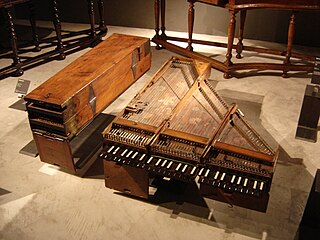
The folding harpsichord was a kind of harpsichord meant for travel. Since it could be folded up into a fairly compact space, it was more easily transported than a conventional harpsichord. The folding took place on hinges and was in the longitudinal dimension, preserving the tension on the strings. The folded instrument formed a package about the size of a large suitcase.
George Catlin (1778-1852) was an American maker of musical instruments. He worked in Hartford, Connecticut from 1799 or earlier until about 1814, when he moved to Philadelphia, Pennsylvania. According to his advertisements in Connecticut newspapers he made pianofortes, harpsichords, violoncellos, guitars, bassoons, clarinets, "hautboys" (oboes), flutes, and fifes.
Jacob Hochbrucker was an eighteenth-century harp maker and musician credited with the invention of the single-action pedal harp popularized in Europe between 1729 and 1750 by his descendants, and particularly by the Dauphine, Marie Antoinette, who performed on it after her arrival in Paris in 1770.
Stanley Harper(néStanley Theodore Wisser; 2 September 1921 – 29 June 2016) was an American virtuoso classical harmonica artist, arranger, and composer. He died June 29, 2016, in a home for the elderly in New Jersey. He raised the popularity of classical harmonica by influencing composers to write for the instrument and by transcribing serious classical works, himself. Through his virtuosity, he widened the recognition of classical harmonica in solo, chamber, and major orchestral settings.

Music technology is the study or the use of any device, mechanism, machine or tool by a musician or composer to make or perform music; to compose, notate, playback or record songs or pieces; or to analyze or edit music.

The psalterion is a stringed, plucked instrument, an ancient Greek harp. Psalterion was a general word for harps in the latter part of the 4th century B.C. It meant "plucking instrument".
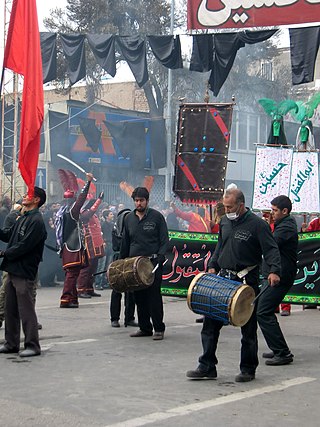
The Dammam is a large double-headed cylinder drum or frame drum played by Shias in Iraq and Iran in religious ceremonies. The dammām is usually struck with the left hand and a curved stick in the right hand, especially during passion plays in the mourning month of Muharram or to wake up the devotees early in the morning of Ramadan.
















